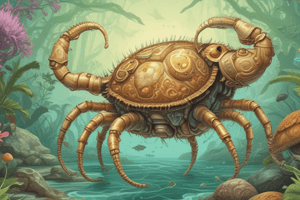Podcast
Questions and Answers
What is an invertebrate?
What is an invertebrate?
- An animal with an exoskeleton
- An animal that lays eggs
- An animal with no backbone or internal skeleton (correct)
- An animal with a backbone
What is the definition of arthropods?
What is the definition of arthropods?
Invertebrates with jointed legs, segmented bodies, some have wings; exoskeletons; gills or air tubes.
Give examples of arthropods.
Give examples of arthropods.
Insects, arachnids, and crustaceans.
What are mollusks?
What are mollusks?
Provide examples of mollusks.
Provide examples of mollusks.
What defines sponges?
What defines sponges?
What characterizes echinoderms?
What characterizes echinoderms?
List examples of echinoderms.
List examples of echinoderms.
What is the definition of segmented worms?
What is the definition of segmented worms?
Provide examples of segmented worms.
Provide examples of segmented worms.
Define exoskeleton.
Define exoskeleton.
What are the 5 groups of invertebrates?
What are the 5 groups of invertebrates?
List examples of amphibians.
List examples of amphibians.
What are endothermic vertebrates?
What are endothermic vertebrates?
How do endothermic vertebrates cool off?
How do endothermic vertebrates cool off?
What does shivering do for endothermic animals?
What does shivering do for endothermic animals?
What are ectothermic vertebrates?
What are ectothermic vertebrates?
How do ectothermic animals warm up?
How do ectothermic animals warm up?
Define autotroph.
Define autotroph.
Define heterotroph.
Define heterotroph.
What is a stimulus?
What is a stimulus?
What is a response?
What is a response?
What is asexual reproduction?
What is asexual reproduction?
What is sexual reproduction?
What is sexual reproduction?
Define growth.
Define growth.
What is development?
What is development?
Define taxonomy.
Define taxonomy.
What are the 5 kingdoms?
What are the 5 kingdoms?
What is phylum in taxonomy?
What is phylum in taxonomy?
What is genus?
What is genus?
What is species?
What is species?
Define vertebrate.
Define vertebrate.
What are the 5 groups of vertebrates?
What are the 5 groups of vertebrates?
What is an endoskeleton?
What is an endoskeleton?
What is the definition of endothermic?
What is the definition of endothermic?
What is the definition of ectothermic?
What is the definition of ectothermic?
Define fish.
Define fish.
What is the definition of amphibian?
What is the definition of amphibian?
What are birds?
What are birds?
Define mammals.
Define mammals.
Study Notes
Invertebrates
- Invertebrates lack a backbone and internal skeleton (endoskeleton).
- Major groups include sponges, segmented worms, echinoderms, mollusks, and arthropods.
Arthropods
- Characterized by jointed legs, segmented bodies, and exoskeletons.
- May possess wings and utilize gills or air tubes for breathing.
- Examples: insects, arachnids, and crustaceans.
Mollusks
- Soft-bodied invertebrates with a muscular foot; some have shells.
- Examples include slugs, snails, clams, and octopuses.
Sponges
- Very simple invertebrates with numerous pores for water circulation.
Echinoderms
- Invertebrates with radial symmetry, arms extending from a central body, and tube feet.
- Examples: sea stars, sea urchins, sea cucumbers, and brittle stars.
Segmented Worms
- Invertebrates with elongated, divided bodies; possess a true nervous system and blood within vessels.
- Examples include earthworms and leeches.
Exoskeleton
- An external skeleton that protects the body of invertebrates.
Vertebrates
- Vertebrates have a backbone, an internal skeleton (endoskeleton), and a complex nervous system with a brain.
- Five major groups: fish, amphibians, reptiles, mammals, and birds.
Endothermic vs. Ectothermic Vertebrates
- Endothermic vertebrates (birds and mammals) maintain constant body temperature; they cool off by sweating or changing positions.
- Ectothermic vertebrates (fish, amphibians, reptiles) have variable body temperatures influenced by their environment; they can warm up by basking in the sun or moving to warmer areas.
Reproductive Strategies
- Asexual reproduction involves only one parent.
- Sexual reproduction requires two parents (egg and sperm).
Taxonomy
- The science of classifying organisms includes five kingdoms: plants, animals, fungi, protists, and monerans.
- The second level of taxonomy, phylum, differentiates animals into vertebrates and invertebrates.
- The genus is the first word in a scientific name, while the species is the most specific classification level.
Growth and Development
- Growth refers to an increase in size, while development describes the process of becoming more complex structurally.
Definitions
- Autotrophs: Organisms that produce their own food (e.g., through photosynthesis).
- Heterotrophs: Organisms that obtain food externally (e.g., through hunting or growing).
- Stimulus: Any change in an organism's environment that provokes a reaction.
- Response: The reaction an organism has to a stimulus.
Studying That Suits You
Use AI to generate personalized quizzes and flashcards to suit your learning preferences.
Description
This quiz focuses on the classification of animals, specifically vertebrates and invertebrates. It covers the definitions and examples of key groups like arthropods and mollusks. Test your knowledge on these essential biological concepts.




